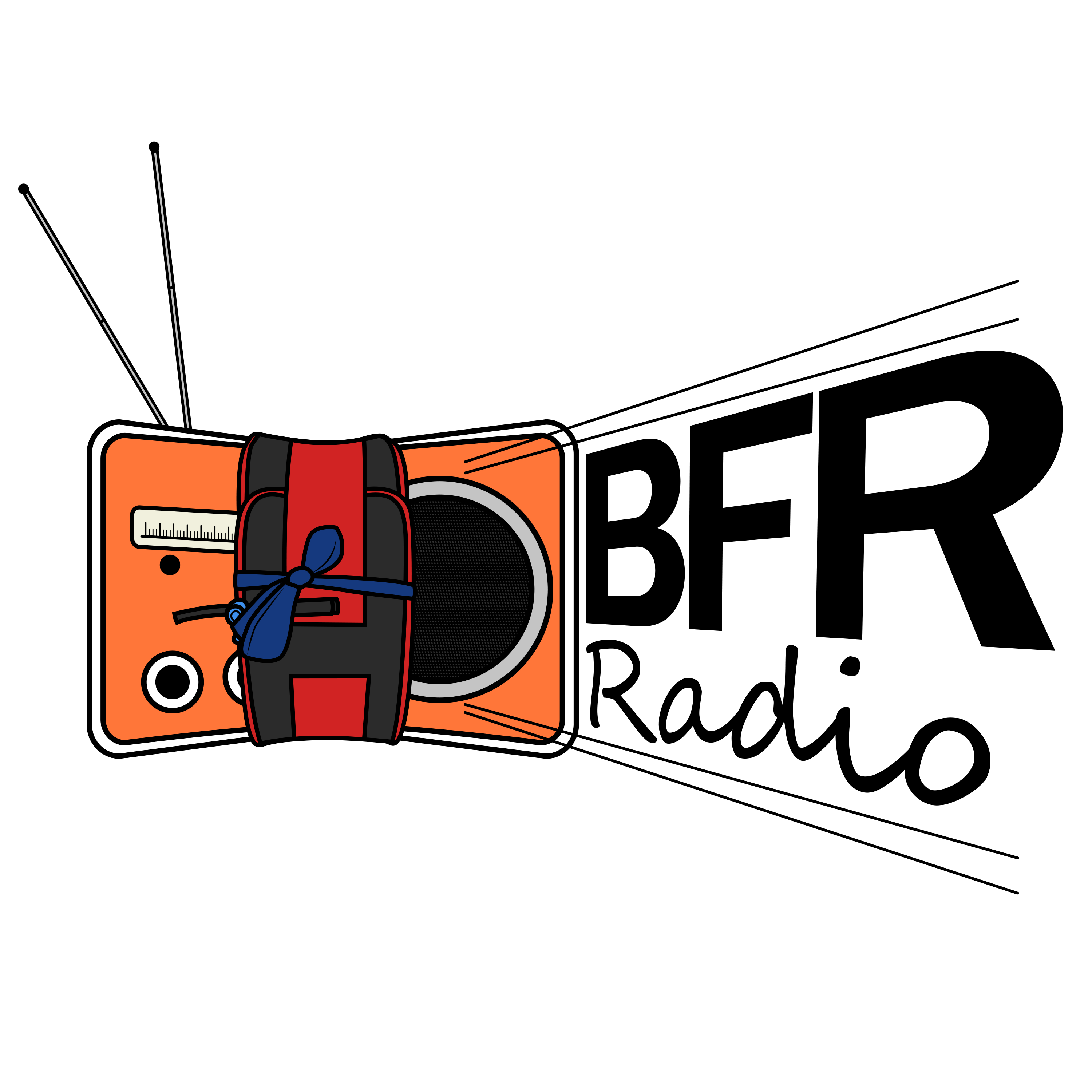Episodes
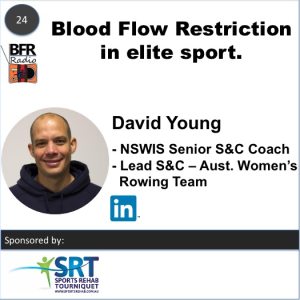
Tuesday Jul 07, 2020
Tuesday Jul 07, 2020
Welcome to this month's episode of BFR Radio.
In exciting news, gyms are back open!
During the COVID period a lot of people may not have had all of the equipment necessary for "traditional" strength training. So during the COVID period I challenged myself away from more traditional high load lifting to create a hybrid strength program that worked around the constraints of not having access to lots of weight. The program involved combining low load training (the max I lifted was 40kg). As I knew that this would be enough external load, I delved into my bag of tricks and used the addition of Isometrics (use of a tie down strap), lifting bands, Blood Flow restriction and Plyometric exercises with a goal to improve athlete performance.
As I‘ve always advocated, there is no substitute for higher external load (i.e. mechanical stress) and therefore the addition of bands and isometric straps provided an additional external loading with the “minimal equipment” challenge and then the addition of BFR was using metabolic stress as a proxy for the mechanical stress that was missing. I’ve been collecting both upper and lower body testing for a few months that has actually predated me even starting this type of training so my preliminary findings are quite interesting. Once I’ve put them together I’ll share with you the results.
In other BFR work, I’ve been working on BFR use framework. Consequently I’ve been increasing my literature reading. There is so much is so many different areas, so if there is anything of particular interest that you want to hear on the podcast let me know and I’ll review those papers.
Today’s guest is NSWIS Senior Coach, David Young who is the lead S&C coach for the Women’s national rowing team based out of Penrith in NSW. As I usually preview a paper before we go into this segment, I actually wished I’d waited for the Rowing Paper I reviewed a few episodes ago. With the information that David will share with us today, I feel that we could have really had a BFR rowing special. And add last month's episode review from Sam Halley on the effects of IPC on kayaking performance (with a potential for it to transfer to rowing performance) then this would have been a really sports specific episode.
I am sure you'll get a lot out of today's episode. David brings a wealth of coaching experience and he really brings some good practical take-aways for BFR use in an elite training environment.
Some more information:
David is a Senior S&C Coach with the New South Wales Institute of Sport, having previously worked at both the English Institute of Sport and the Sports Council for Wales. During his 16 years in High Performance Sport David has worked across a wide range of Olympic and Commonwealth sports. Since 2006, he has worked with rowing programs in the UK and Australia, being fortunate enough to support athletes to numerous World, Olympic and Paralympic medals.
His current role sees him deliver S&C services to Rowing Australia’s Hancock Prospecting Women’s National Training Centre based in Penrith. David has a Master’s degree from the University of Sydney and ongoing industry accreditations with the ASCA, UKSCA and NSCA.
Contact him via LinkedIn or via email: David.Young@nswis.com.au
For more information or to order your own set of BFR cuffs please visit my website: www.sportsrehab.com.au
Thanks for next listening and see you next month.
Chris
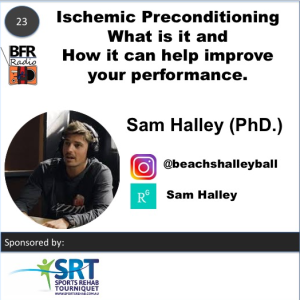
Monday Jun 15, 2020
Monday Jun 15, 2020
Thanks for joining in for this month's episode.
In this episode I am joined by Sam Halley who hopefully by the time this episode airs should have officially completed and be awarded his PhD. His PhD focused on the area of Ischemic Preconditioning (IPC) and this podcast will essentially be 2 parts.
The first section revisits what IPC is, what this means for exercise performance and some of his own work looking at the effect of IPC on nqurmusucalr function during intense exercise. The second part takes the concept of IPC into the real world of sporting performance. It looks at how the application of IPC on kayak 1000m performance.
The advantage of IPC is that it is a passive intervention that comprises of three to four 5 minute alternating cycles of blood flow occlusion and reperfusion across limbs. Exercise performance trials have demonstrated small, albeit inconsistent, ergogenic effects during aerobic and exhaustive tasks. His work with kayak athletes is well worth the listen.
We also discuss how this type of intervention could be of benefit with other athletes and in particular he highlights the potential for big-wave surfers and swimmers. Sam covers a lot in this podcast with a lot of practical take-aways.
If you want to contact him, his details are:
Instagram: https://www.instagram.com/beachshalleyball/
Email: slhalley07@gmail.com
Researchgate: Sam Halley
I hope you enjoyed this episode.
For more information or to order your own set of BFR cuffs please visit my website: www.sportsrehab.com.au

Friday May 22, 2020
Friday May 22, 2020
Hi everyone,
This month is jam packed full of great information. From a general training viewpoint, in Australia we are starting to see an ease of COVID-19 restrictions and this result in being able to access indoor training and gym facilities. It is therefore important to reload the body sensibly over the next month. For those who don't currently have access to sufficient training facilities (i.e. strength equipment) his is where I see BFR can be a good training addition.
Today's guest is ParaOlympian Sam Tait who I was suggested to get onto the podcast by a previous guest and Sam's S&C coach, Kelly Beahan. Sam is a complete T10 paraplegic and is an elite athlete who competes in the winter-based sport of sit skiing. Sam competed at the 2018 Winter Paralympics where he came 11th in downhill and a year later competed at the 2019 World Championships and finished 6th in downhill. Through Kelly's guidance, Sam really uses BFR to its full potential. His story is great so I thank him again for coming onto the podcast.
You can check what he is up to via:
Instagram: https://www.instagram.com/samtait_7/
Website: https://www.samtait.com.au
Also, check out Kelly Beahan who has been instrumental in helping with his physical preparation: Instagram: https://www.instagram.com/itskel/
As I was putting this episode together ad trying to find relevant articles, I felt it was themed around Spinal Cord Injuries. Although I couldn't find an article that was sporting related, I did find one that was related to general function and felt this may provide some useful information and ideas for those who have spinal cord injuries and rehab specialists.
The article I review is:
Electrical Stimulation and Blood Flow Restriction Increase Wrist Extensor Cross-Sectional Area and Flow Meditated Dilatation Following Spinal Cord Injury
Abstract
Purpose: To examine the effects of neuromuscular electrical stimulation (NMES) and blood flow restricted (BFR) exercise on wrist extensors cross-sectional area (CSA), torque and hand functions compared NMES only in individuals with incomplete tetraplegia. The acute effect of an acute bout of NMES with BFR on flow mediated dilation (FMD) was compared with BFR only.
This is a great article that if you are interested in knowing more about to go and download it.
As I am talking about Spinal Cord Injuries, I thought it was also useful to highlight contraindications and indications to BFR. There is a fantastic article that I refer to here:
Key considerations when conducting KAATSU training
Thanks for listening.
Chris

Tuesday Apr 21, 2020
BFR - Pain Relief, Performance training and a World Record with Jacinta Carroll
Tuesday Apr 21, 2020
Tuesday Apr 21, 2020
Hi there.
I hope everyone is doing well. With the current COVID-19 situation we are all in, I feel that BFR is placed really well for everyone irrespective of whether you are performing injury rehab or training for elite athletic performance. There is a lot of evidence that it is a great training tool is both of these scenarios.
This brings me to today's episode and it is over 12 months in the making. I get straight into "How you do BFR" with Jacinta Carroll. She brings a fantastic story and has multiple stories of how to use it in both an injury and performance sporting environment. I feel words don't do her justice to her CV but aside from being an elite athlete in two sports, a world record holder in one of them and a Physiotherapist, her interview is jam packed full of great applications of BFR.
A quick snapshot of her career so far:
- 4 x world champion in Waterski Jumping (Currently undefeated for the last 40 international pro tour stops).
- Ranked 2nd in the 59kg division got Olympic Weightlifting in Australia.
- Full time physiotherapist.
- Currently studying Masters of Sports Physiotherapy.
You can follow her journey on instagram: @jacintacarroll and if you like her bikinis checkout her swimwear sponsor: @finkitaswimwear
If you are interested in starting Blood Flow Restriction go straight to my website (www.sportsrehab.com.au) to purchase your own set.
Thanks for listening.
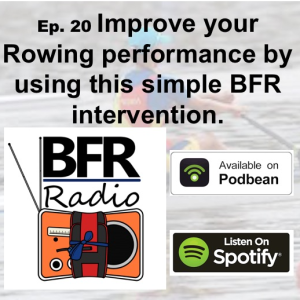
Monday Mar 09, 2020
Improve your Rowing performance by using this simple BFR intervention.
Monday Mar 09, 2020
Monday Mar 09, 2020
Hi there and welcome to this month's episode.
In this article review I look at a recent paper that investigated the use of Blood Flow Restriction cuffs whilst rowing at low intensities to improve aerobic (VO2max) capacity in elite rowing athletes. There is growing evidence in using Blood Flow Restriction during low intensity exercise (i.e. jogging, cycling and now rowing) whilst performing sport specific movement to improve performance parameters.
The other interesting point in this article is that they used elite athletes. The ability to improve performance in elite athletes is difficult and therefore the results that they showed in this article provides a great reason to look towards finding ways to incorporate BFR into athlete's training programming.
So whether you are a rower or an athlete looking to improve your aerobic I feel that there is definitely a place for including Blood Flow Restriction into your training. As per the article, it BFR was added during their low intensity exercise sessions making it an easy addition to your own training.
For more information about BFR or to purchase your own set of occlusion training cuffs please come over to my website www.sportsrehab.com.au.
Thanks for listening.
For more information on the article:
Low intensity rowing with blood flow restriction over 5 weeks increases V̇O2max in elite rowers: A randomized controlled trial.
Abstract
OBJECTIVES:
The present randomized controlled intervention study examined the effects of practical blood flow restriction (pBFR) on maximal oxygen uptake (V̇O2max) during low intensity rowing.
DESIGN:
Thirty-one elite rowers were either assigned to the intervention (INT) or control (CON) group, using the minimization method (Strata: Gender, Age, Height, V̇O2max).
METHOD:
While INT (n=16; 4 female, 12 male, 21.9±3.2 years, 180.4±8.7cm, 73.6±10.9kg, V̇O2max: 63.0±7.9ml/min/kg) used pBFR during boat- and indoor-rowing training, CON (n=15, 4 female, 11 male, 21.7±3.7 years, 180.7±8.1cm, 72.5±12.1kg, V̇O2max: 63.2±8.5ml/min/kg) completed the identical training without pBFR. pBFR of the lower limb was applied via customized elastic wraps. Training took place three times a week over 5 weeks (accumulated net pBFR: 60min/week; occlusion per session: 2-times 10min/session) and was used exclusively at low intensities (<2mmol/L). A spiroergometric ramp test (V̇O2max; 30-40W/min increase) on rowing-ergometer and one-repetition maximum test of the squat exercise (SQ1RM) was employed to assess endurance and strength capacity.
RESULTS:
Significant group×time interactions (ηp²=0.26) in favor of INT were found for V̇O2max (+9.1±6.2%, Effect Size=1.3) compared to CON (+2.5±6.1%, ES=0.3). SQ1RM (ηp²=0.01) was not affected by the pBFR intervention.
CONCLUSIONS:
This study revealed that 15 sessions of pBFR application with a cumulative total pBFR load of 5h over a 5 weeksmacrocycle remarkably increased V̇O2max. Thus, pBFR might serve as a promising means to improve aerobic capacity in highly trained elite rowers.

Tuesday Feb 18, 2020
Tuesday Feb 18, 2020
Hi there and thanks for tuning in for this month's episode.
Today's topic is actually a request from one of our follower listeners (thanks Dann) who wanted to hear about the role of BFR and muscle stems cells. The topic of muscle stem cells alone is fascinating where stem cells are present in skeletal muscle tissue and they can self-renew and are capable of giving rise to skeletal muscle cells. Stem cells are activated in response to muscle injury to regenerate damaged muscle tissue. So whether we are talking about general or athletic populations, the ability to activate or enhance muscle stem cell response around injury has fantastic implication for recovery.
As it worked out, I had an article in mind. I also try to explain some of the terms used in the paper to make it easy for you all to understand. I hope you enjoy it as much as I did reviewing it. If you have any other topics of particular interest please comment through my pod bean account, website or social media (@chrisgaviglio).
The paper I review is:
Proliferation of myogenic stem cells in human skeletal muscle in response to low-load resistance training with blood flow restriction.

Tuesday Jan 28, 2020
Tuesday Jan 28, 2020
Happy New Year everyone.
Today's podcast looks into low load BFR training and achilles tendons. This is quite an exciting paper due to the positive effects of Blood Flow Restriction training with tendon adaptation. Previously only high load strength training has shown positive responses to tendon so this is a great result for what BFR can bring to the user - i.e. we can finally use low load training to elicit a tendon response (with the addition of BFR).
The other advantage of this session was how simple it was. There was a couple of points that I feel are quite important to note. Firstly, it was a 14-week training intervention. Typically a lot of academic studies are of 4-6weeks in lengths and probably this is why previous studies may not have shown positive training responses. The other point, was an incremental loading protocol - although the loads were still low (20-35% 1RM) every 4 weeks the load was increased by 5% and the subjects' max strength was reassessed and readjusted. This highlights that the body needs a continual increase in strength, even if we are using low-load BFR training. Therefore we can start to look at bringing this type of training to an "at-home" situation providing a simple solution for everyone.
This same principle for other tendons (esp. shoulder and patella) I feel can also be applied. I've had great success with tendon issues acutely and this paper highlights that a longer (14 week) approach to tendon adaptation is needed.
The article I review today is:
Low-load blood flow restriction training induces similar morphological and mechanical Achilles tendon adaptations compared with high-load resistance training.
J Appl Physiol 2019 Dec 1;127(6):1660-1667. doi: 10.1152/japplphysiol.00602.2019. Epub 2019 Nov 14.
Abstract
Low-load blood flow restriction (LL-BFR) training has gained increasing interest in the scientific community by demonstrating that increases in muscle mass and strength are comparable to conventional high-load (HL) resistance training. Although adaptations on the muscular level are well documented, there is little evidence on how LL-BFR training affects human myotendinous properties.
Therefore, the aim of the present study was to investigate morphological and mechanical Achilles tendon adaptations after 14 wk of strength training. Fifty-five male volunteers (27.9 ± 5.1 yr) were randomly allocated into the following three groups: LL-BFR [20-35% of one-repetition maximum (1RM)], HL (70-85% 1RM), or a nonexercising control (CON) group.
The LL-BFR and HL groups completed a resistance training program for 14 wk, and tendon morphology, mechanical as well as material properties, and muscle cross-sectional area (CSA) and isometric strength were assessed before and after the intervention. Both HL (+40.7%) and LL-BFR (+36.1%) training induced significant increases in tendon stiffness (P < 0.05) as well as tendon CSA (HL: +4.6%, LL-BFR: +7.8%, P < 0.001). These changes were comparable between groups without significant changes in Young's modulus.
Furthermore, gastrocnemius medialis muscle CSA and plantar flexor strength significantly increased in both training groups (P < 0.05), whereas the CON group did not show significant changes in any of the evaluated parameters.
In conclusion, the adaptive change in Achilles tendon properties following low-load resistance training with partial vascular occlusion appears comparable to that evoked by high-load resistance training.NEW &
Before you go and listen to the podcast could I ask a couple of favours:
1. If you know of someone who is suffering from achilles tendon issues please get them to listen to this podcast.
2. If you are enjoying the podcast please give it a positive rating on iTunes.
Thanks for listening.
In the methods, there was a couple of points around how Tendon properties was calculated and I mentioned that I would put it in the notes:
How did they measure Tendon Stiffness?
To assess tendon stiffness, elongation of the Achilles tendon was determined during ramped isometric contractions by B-mode US scans at 100 Hz at the gastrocnemius medialis myotendinous junction
After familiarization with the procedure and preconditioning of the tendon with five trials at 80% of MVC, participants were instructed to steadily exert torque to their individual maximum with a standardized loading rate of 50 Nm/s. This loading rate was chosen because it resulted in a ramped isometric plantar-flexion contraction lasting between 3 and 5 s for all subjects. During this process, visual online feedback of the torque signal was provided. Achilles tendon force was calculated by dividing plantar flexion torque by the tendon moment arm with a subsequent correction for ankle joint rotation by kinematic data
Tendon moment arm was calculated by measuring the perpendicular distance from the inferior tip of both medial (L1) and lateral (L2) malleolus (center of rotation) to the posterior part of the Achilles tendon. For this purpose pictures were taken from the medial and lateral sagittal planes (Sony Cyber-shot DSC-RX100 Digital Camera). In accordance with previous studies, the mean of these two measurements (L1,2) was used for further calculations. Subsequently, the intersection of L1 and L2 was indicated with a needle and the perpendicular distance (M) from the needle to the tendon’s line of action was measured (32). Tendon moment arm was then determined by subtracting M from L1,2 (for detailed descriptions see Refs. 32 and 50). All analyses were conducted with ImageJ (1.51; NIH).
Tendon stiffness was then calculated as the slope of the force-elongation curve between 50% and 80% MVC. This procedure has previously been used in the scientific literature (56). Young’s modulus was calculated as the slope of the stress-strain curve between 50% and 80% MVC.
What is Young’s Modulus?
Young's modulus is a measure of the ability of a material to withstand changes in length when under lengthwise tension or compression. Sometimes referred to as the modulus of elasticity, Young's modulus is equal to the longitudinal stress divided by the strain.
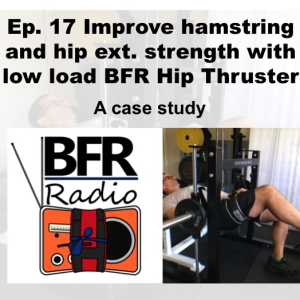
Monday Dec 09, 2019
Improve hamstring and hip extension strength with low load BFR Hip Thruster
Monday Dec 09, 2019
Monday Dec 09, 2019
Hi,
This is the last episode for 2020 and brings to a close a big year for me. I've started my accredited BFR workshop, seen BFR Podcast and the product demand grow. I've also designed my first piece of strength training equipment called the G-Thruster. It is a machine to help with the Hip Thruster movement and the feedback has been great. So today's episode is a case study looking at how using the Hip Thruster (G-Thruster) could be utilised to improved strength and hypertrophy of the lower body.
It utilises a high-frequency (daily) and low load training methodology as per other BFR studies. Other strength-based studies (i.e.Squat, Leg Extension and Bench Press), high frequency (daily or twice daily) training using low load BFR has reported significant improvements in muscle hypertrophy and strength measures.
This case study also incorporates a few other important points:
- The muscular response to BFR training has been shown to be both distal and proximal to the cuffs. Furthermore, it is the exercise that uses specific muscles that gets the desired response. In other words, if you want response of the gluteals with BFR you need to incorporate Hip Extension and Glute biased exercise.
- Hip thruster movement has been shown to be an effective PAP for sprinting, which leads to a potentially good exercise to incorporate into strength training programs. Furthermore, the hip thruster is a great strength stimulus for athletes who can't load heavy axially through the spine (e.g. squat).
The case study involved the following:
- 2 weeks - daily (3 x week - twice daily)
- Hip thruster - double (+40kg) and single leg (+20kg)
- Reps x sets - Set 1 = 20-30reps, Set 2-4 = 10-15reps
- BFR - continuous pressure (50% AO) using a 10cm wide cuff
- Measurements:
- Girth: Glutes (max circumference) and thigh (3 points: proximal third, mid-thigh & distal third)
- Strength measure - Single Leg isometric maximal force output
- Glute (knee at 90deg)
- Hamstring (knee at 170-180 deg)
Although the case study on me, my measurements are relatively stable so any changes would be due to the new stimulus.
The podcast goes through the results however I did see some very interesting girth and strength improvements lending support to using this type of training for athletes that are injured or trying to quickly accelerate change during specific time periods.
In closing for the year, thank you for your support. I appreciate your interaction and comments.
See you in 2021 for a bigger and better year.
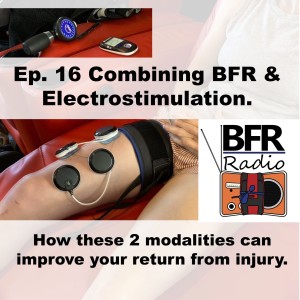
Thursday Nov 07, 2019
BFR & Electrostimulation - combining modalities to accelerate injury recovery
Thursday Nov 07, 2019
Thursday Nov 07, 2019
Hi everyone,
With this episode of BFR Radio I was inspired by a recent post from a colleague who started to use a combination modality of BFR and Electrostimulation (EMS) for an athlete who was going through post ACL surgery rehab. Traditionally EMS requires a high level of intensity for it to be effective which is problematic for those who are in the acute postoperative stage. This is where the authors thought that the combination of BFR with a lower level of EMS may prove to be useful.
Before you head off and listen to the podcast, a few exciting updates:
- This week I am at the ASCA annual conference on the Gold Coast. I will have my Sports Rehab Tourniquets there to try and I am also debuting a new strength machine that I have developed. To date I haven't not seen this machine before so potentially a world debut.
- I am running a Brisbane BFR workshop on Saturday 23 November. Tickets can be purchased online only through eventbrite. There are lots of links through my social media and blog post. Click on this link to purchase your ticket Click on this link to purchase your Brisbane BFR Workshop Ticket (direct link to Eventbrite page)
Hope you enjoy the podcast.
The Effects of Blood Flow Restricted Electrostimulation on Strength and Hypertrophy.
Abstract
CONTEXT:
The combined effect of neuromuscular electrical stimulation (NMES) and blood flow restriction (BFR) on muscle mass and strength has not been thoroughly investigated.
OBJECTIVE:
To examine the effects of combined and independent BFR and a low-intensity NMES on skeletal muscle adaptation.
MAIN OUTCOME MEASURES:
Subjects had each leg randomly allocated to 1 of 4 possible intervention groups: (1) cyclic BFR alone, (2) NMES alone, (3) BFR + NMES, or (4) control. Each leg was stimulated in its respective intervention group for 32 minutes, 4 days per week for 6 weeks. Mean differences in size (in grams) and isometric strength (in kilograms), between week 0 and week 6, were calculated for each group.
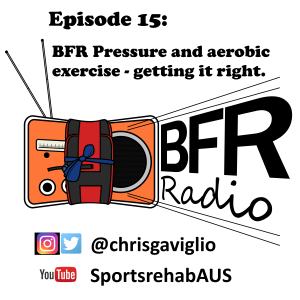
Tuesday Oct 08, 2019
Optimising BFR pressures for aerobic exercise
Tuesday Oct 08, 2019
Tuesday Oct 08, 2019
Hi everyone,
Things have been a little busy lately hence the late podcast. With my normal S&C work commitments and a few workshops to prepare for I haven't been able to put together my normal schedule of podcasts. Today's podcast actually appeared on another podcast Snippit Sports Science of which my mate, Jared and I produce.
Speaking about workshops, I will be in Sydney on Saturday October 13th (2 weeks time) to do a new BFR workshop. Tickets are available through Eventbrite (click on this link to buy your ticket). Alternatively if you know of someone who'd benefit from this workshop I'd appreciate you letting them know and sharing the link.
Today's episode from a practical standpoint helps to understand the optimisation of Blood Flow Restriction pressures when doing aerobic (stationary-based) exercise. I personally have found that dropping my pre-determined BFR pressure by around 20mmHg works best and that if I stayed at this pressure (I usually do my strength training at) it is just doesn't feel right and is too high. The debate of BFR pressures is an ongoing on and this article helps shed some light as to some great evidence.
Effects of DifferentPercentages of Blood Flow Restriction on Energy Expenditure.
Int J Sports Med.2019 Mar;40(3):186-190. doi: 10.1055/a-0828-8295. Epub 2019 Jan 31.
Abstract
The study aimed to analyze the effect of differentlevels of bloodflowrestriction(BFR) on energyexpenditure(EE) and subjective perceptions of discomfort (SPD) during aerobic exercises.
A sample group of 24 young men was required to walk on a treadmill for 14 min at 40% of their maximum speed, with 4 differentpercentagesof BFR (0, 50, 80 and 100%) applied in the lower limbs (LL) once a week with a 7-day interval between the 4 evaluations. EE data were collected during the exercise periods; SPD data were collected after the exercises.
There was a significant increase in EE at 50, 80 and 100% BFR compared to the condition without BFR, and between 50 and 100% BFR; however, there were no differences between 50 and 80% and 80 and 100% BFR. Discomfort showed a significant increase according to the increase in BFR. During the walking exercises with BFR, the EE strongly increased until 50% of BFR; after this level the additional increases slowed.
It can be concluded that when performing aerobic exercises with BFR, there is no need to use BFR levels above 50% to reach satisfying level of EE with only a moderate level of discomfort to the practitioner.
Snippit Sports Science Podcast is sponsored by EliteForm, which brings together cutting edge Velocity Based Training technologies. Please visit https://eliteform.com and check out their products, StrengthPlanner and PowerTracker.
If you want any more information about BFR training or want to purchase your own set of BFR cuffs please visit my website: www.sportsrehab.com.au

